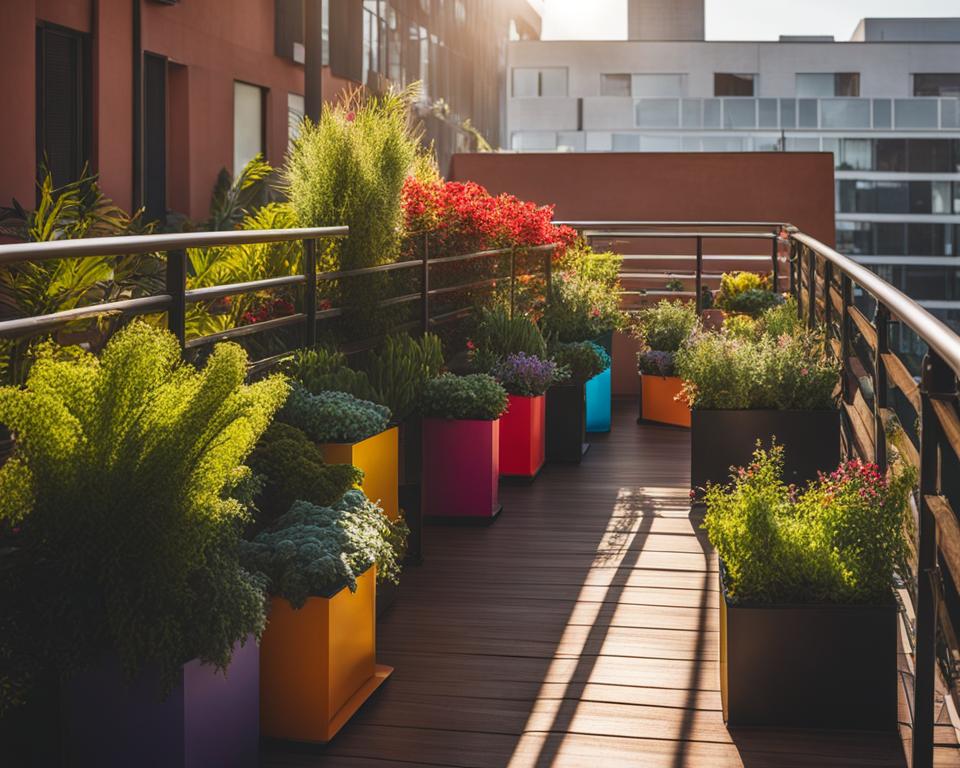Welcome to my guide on DIY vertical urban gardening! If you’re looking to expand your gardening space and create a productive oasis in your urban setting, you’ve come to the right place. In this article, I’ll share my experience and provide you with DIY ideas for successful vertical gardening projects.
Vertical gardening is an affordable and easy-to-set-up method that not only saves space but also improves harvesting, protects your plants from disease, and adds a stunning design element to your garden. Whether you have a small balcony or a backyard, vertical gardening can transform any space into a lush, green paradise.
With the use of trellises, pallets, or hanging gardens, you can create a vertical garden that suits your space and gardening needs. By being resourceful and thinking outside the box, you can save money while achieving incredible results.
Choosing the right plants for vertical gardening is crucial. Climbing beans or peas, cucumbers, melons, squashes, tomatoes, and herbs like basil and mint are all excellent choices for vertical growth. Consider the light and water requirements of different plants when planning your vertical garden.
When it comes to success in vertical gardening, factors such as soil choice, watering, and environmental conditions play a significant role. Using a suitable soil mix, providing adequate watering, and understanding the sunlight and temperature needs of your plants are essential for their health and growth.
Pre-growing your plants before transplanting them into your vertical garden ensures their resilience and allows for experimentation with garden design. By starting plants indoors or in temporary outdoor locations, you can acclimate them to their final vertical position.
Building a DIY vertical garden requires careful planning and step-by-step execution. Choosing a location, gathering materials, preparing the structure, and selecting the right plants are all part of the process. Remember to provide ongoing care and maintenance to ensure a thriving vertical garden.
Vertical urban gardening is not only a sustainable solution but also a beautiful way to bring nature into your city space. So, why wait? Start your own DIY vertical garden today and enjoy the benefits of urban gardening at its finest!
The Benefits of Vertical Gardening
Vertical gardening offers numerous benefits for urban gardeners. It is an innovative and space-saving solution that allows you to maximize limited areas and create a lush green oasis even in the heart of the city. With vertical gardening, you can make the most of your available space, improve plant health, and enhance the aesthetic appeal of your garden.
One of the key advantages of vertical gardening is its ability to maximize limited space. By growing plants upwards instead of outwards, you can utilize walls, fences, or trellises to create a vertical garden that takes up minimal ground space. This is especially beneficial for urban dwellers with small balconies or courtyards who still want to enjoy the joys of gardening.
Vertical gardens also provide easier access to plants, making harvesting a breeze. With plants arranged vertically, you don’t have to search through dense foliage to find ripe fruits or vegetables. Everything is within reach, enabling you to enjoy the fruits of your labor more conveniently.
Vertical gardening improves plant health by keeping them off the ground and away from disease-causing organisms.
Furthermore, vertical gardening can improve the health of your plants. By keeping them off the ground, you can protect them from disease-causing organisms that may be present in the soil. This reduces the risk of plant infections and increases their overall vitality. Vertical gardening also allows for better airflow around the foliage, which can further prevent the development of fungal diseases.
Another advantage of vertical gardening is its ability to add beauty and structure to your garden design. By arranging plants vertically, you can create visually stunning displays that add architectural interest to your outdoor space. Whether you choose to grow vibrant flowers, cascading vines, or a combination of both, vertical gardening allows you to create a green backdrop that enhances the overall aesthetic appeal of your garden.
With its space-saving benefits, improved plant health, and enhanced garden design, vertical gardening is a fantastic option for urban gardeners. Whether you have a small balcony, a rooftop, or a courtyard, you can create your own vertical garden and enjoy all the joys of gardening in the concrete jungle.
The Benefits of Vertical Gardening
Affordable DIY Vertical Gardening Ideas
If you’re looking to create a vertical garden without breaking the bank, there are plenty of affordable DIY options to consider. By using alternative materials and getting creative, you can save money while still achieving a beautiful and functional vertical garden.
Using Cost-Effective Materials
Instead of purchasing expensive trellises or supports, you can repurpose affordable materials to create sturdy structures for your vertical garden. Consider using welded wire, T-posts, cattle panels, chicken wire, or recycled fencing. These materials can be easily obtained and are often more budget-friendly than store-bought options. By thinking outside the box and being resourceful, you can create a vertical garden on a budget.
Upcycling Items for Vertical Gardening
Another way to save money is by upcycling items for your vertical garden. Look for unused or discarded objects that can be transformed into planters or hanging containers. Old pallets can be repurposed into a vertical planter, while shoe organizers or hanging baskets can be used to hold plants and create a vertical garden in small spaces. With a bit of creativity, you can turn everyday items into unique vertical gardening solutions.
| Materials | Estimated Cost |
|---|---|
| Welded wire | $10-$15 |
| T-posts | $2-$4 each |
| Cattle panels | $20-$30 |
| Chicken wire | $5-$10 |
| Recycled fencing | Varies (often free) |
With these affordable DIY ideas, you can create a vertical garden that not only saves space but also adds beauty and functionality to your outdoor or indoor space. Let your imagination guide you and enjoy the rewards of a thriving vertical garden without breaking the bank.
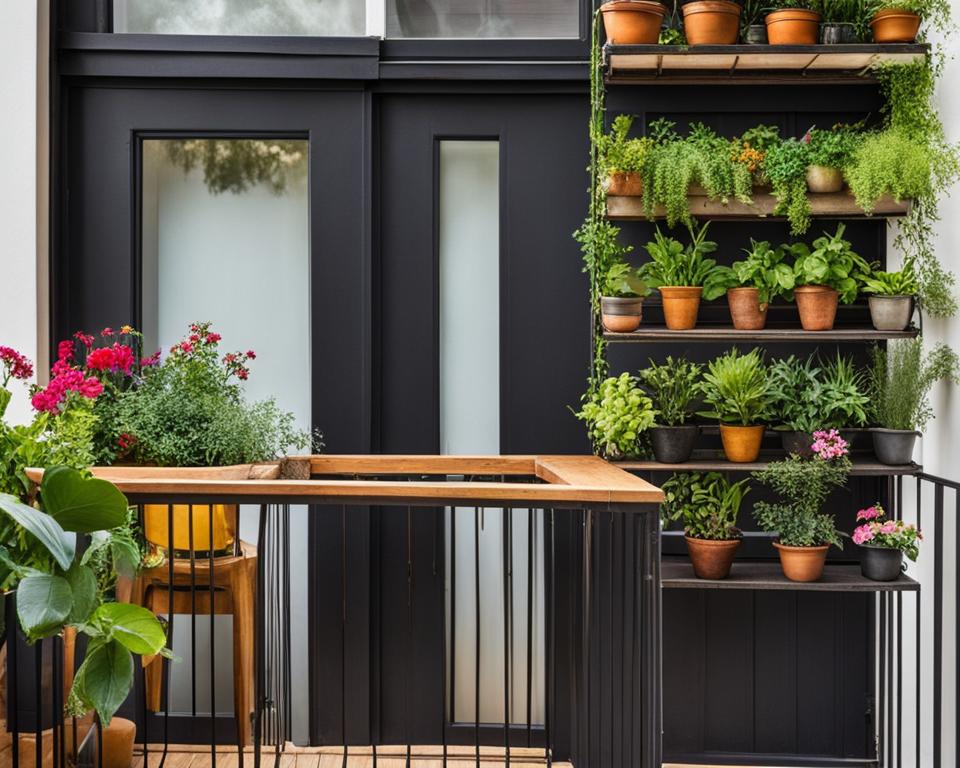
Best Plants for Vertical Gardening
When it comes to vertical gardening, choosing the right plants is crucial for a successful and flourishing garden. Certain plants are well-suited for vertical growth, allowing you to maximize your gardening space and enjoy bountiful harvests. Here are some of the best plants to consider for your vertical garden:
Climbing Beans or Peas
Climbing beans or peas are excellent choices for vertical gardening. These plants naturally climb and can be trained on trellises or supports. They not only save space but also produce a high yield of delicious beans or peas that are easy to harvest.
Cucumbers and Melons
Cucumbers and melons are vining plants that thrive when grown vertically. By training them on trellises or cages, you can prevent them from sprawling on the ground and protect the fruits from rotting. Vertical growth also promotes better air circulation, reducing the risk of diseases.
Squashes
Similar to cucumbers and melons, squashes can be trained to grow vertically. By providing adequate support, such as a sturdy trellis, you can prevent the sprawling vines from taking over your garden space. Vertical gardening also helps keep the fruits off the ground, reducing the risk of rotting and pest damage.
Tomatoes
Tomatoes are a popular choice for vertical gardening due to their vertical growth habit and abundant fruit production. By using stakes, cages, or trellises, you can support the tomato plants and ensure they grow in an upright manner. Vertical gardening allows for easier maintenance, harvesting, and disease prevention.
Herbs
Herbs like basil, thyme, and mint are ideal for vertical gardens. They don’t require much space and can be regularly harvested for culinary purposes. By growing herbs vertically, you can have a convenient and compact herb garden right outside your kitchen.
These are just a few examples of plants that can thrive in a vertical garden. Consider the light requirements, water needs, and the amount of space you have when selecting plants for your vertical garden. By choosing the right plants and providing proper support, your vertical garden will flourish and bring you joy throughout the growing season.
DIY Vertical Garden Options
Creating a DIY vertical garden provides endless possibilities for adding greenery to your space. Whether you have a small balcony or a large backyard, there are various options to suit your needs and preferences. Let’s explore some popular DIY vertical garden ideas:
- Hanging Garden: Perfect for small spaces, a hanging garden allows you to utilize vertical space by suspending plants from overhead structures or hooks. You can use hanging baskets, planters, or even repurpose old containers to create a stunning display of cascading plants.
- Trellis or Lattice Against a Wall: By installing a trellis or lattice against a wall, you can transform a blank space into a vibrant vertical garden. This option is ideal for climbers like vines, flowers, or vegetables. It not only adds beauty to your outdoor area but also provides privacy and shade.
- Upcycled Pallet Planter: Give new life to an old wooden pallet by turning it into a vertical planter. Securely attach pots or containers to the pallet’s slats, add potting soil, and plant your favorite herbs, flowers, or succulents. Hang the pallet vertically or lean it against a wall for a unique and eco-friendly garden.
- Tower Garden: If you have a larger space and want to grow a wide variety of herbs and vegetables, a tower garden is an excellent option. These vertical structures consist of multiple stacked containers or trays, allowing you to grow plants at different heights. Tower gardens are efficient and visually appealing, making them a popular choice for urban gardeners.
Remember to choose the option that best suits your available space, sunlight conditions, and plant preferences. Each DIY vertical garden option offers its own unique advantages and design possibilities. Enjoy the process of creating your own vertical garden and watch as it transforms your space into a flourishing oasis of green!
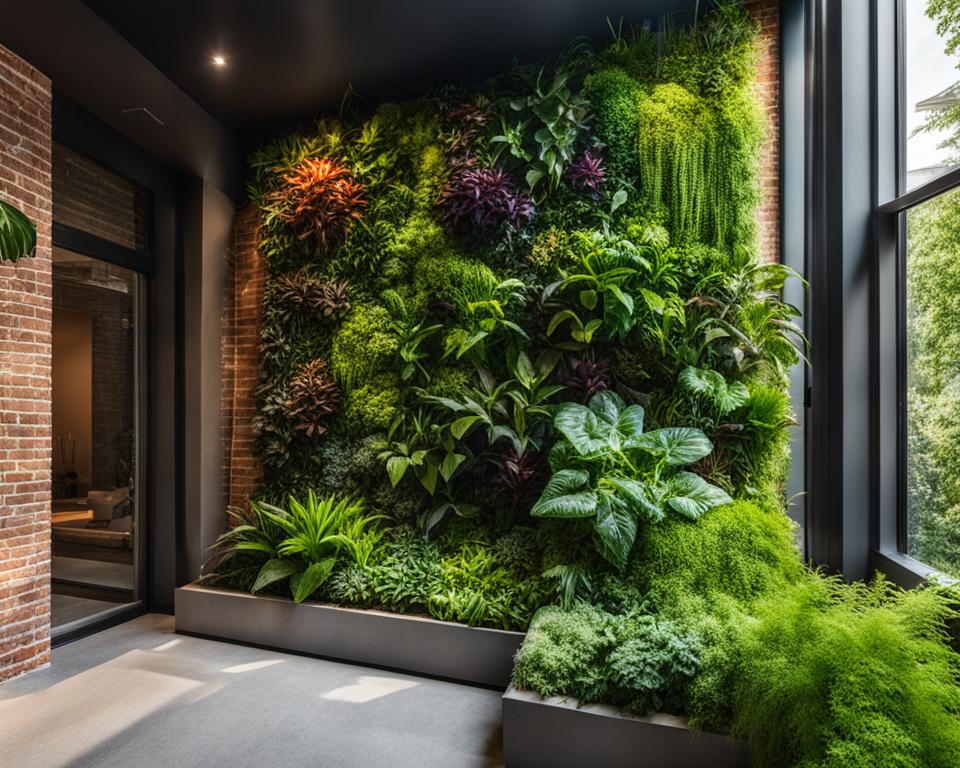
Table: DIY Vertical Garden Options
| Vertical Garden Option | Description |
|---|---|
| Hanging Garden | An excellent choice for small spaces, hanging gardens utilize vertical space by suspending plants from overhead structures or hooks. |
| Trellis or Lattice Against a Wall | Transform a blank wall into a vibrant vertical garden by installing a trellis or lattice. Ideal for climbers like vines, flowers, or vegetables. |
| Upcycled Pallet Planter | Repurpose an old wooden pallet by attaching pots or containers to its slats and creating a vertical planter. Perfect for herbs, flowers, or succulents. |
| Tower Garden | A larger option for growing a variety of herbs and vegetables. Consists of stacked containers or trays, offering different heights for planting. |
Factors for Success in Vertical Gardening
In order to achieve success in vertical gardening, there are several key factors that need to be considered. These factors will ensure that your plants thrive in their vertical environment and produce a bountiful harvest. Let’s take a closer look at some important tips and tricks for vertical gardening:
- Soil Choice: Selecting the right soil is crucial for the success of your vertical garden. Opt for a soil mix that is specifically formulated for container gardens or create your own mix using peat moss, perlite, and vermiculite. This will provide the necessary nutrients and drainage for your plants to grow.
- Water Requirements: Watering is especially important in vertical gardens as the soil volume is limited. Ensure that your plants receive adequate moisture by watering them regularly. Consider using a drip irrigation system or self-watering containers to make watering more efficient.
- Environmental Factors: Pay attention to the sunlight and temperature needs of your plants. Different varieties have different requirements, so choose plants that are suitable for vertical growth in your specific climate conditions. Additionally, consider the wind exposure in your vertical garden location and provide support or protection if necessary.
By taking these factors into account, you will set yourself up for success in your vertical gardening endeavors. Remember to choose the right soil, provide adequate water, and consider the environmental conditions for your plants. With proper care and attention, your vertical garden will flourish and reward you with a beautiful and abundant harvest.
Pre-Growing Tips for Vertical Gardens
When it comes to creating a successful vertical garden, pre-growing plants can greatly enhance their health and resilience. By starting plants indoors or in a temporary outdoor location, you can provide optimal growing conditions and allow them to acclimate gradually to their new environment. This pre-growing process also allows for experimentation with garden design and layout, ensuring a stunning and well-planned vertical garden.
Starting plants indoors is a popular method for pre-growing. You can use pots or seed trays to provide the ideal growing conditions, such as controlled temperature and lighting. This approach allows you to closely monitor the plants’ progress and adjust care as needed. Once the plants have established strong roots and developed robust foliage, they are ready to be transplanted into your vertical garden.
Another pre-growing method is to start plants in a temporary outdoor location. This allows them to acclimate to natural conditions gradually. By doing so, the plants become more resilient and better equipped to thrive in their final vertical garden setting. Be sure to consider factors such as sunlight exposure, temperature variations, and water requirements during this pre-growing phase.
Overall, pre-growing plants for your vertical garden is a crucial step that sets the foundation for success. Whether you choose to start them indoors or in a temporary location, this method ensures healthier, more adaptable plants. Don’t underestimate the importance of this pre-growing phase, as it can make a significant difference in the overall performance and beauty of your vertical garden.
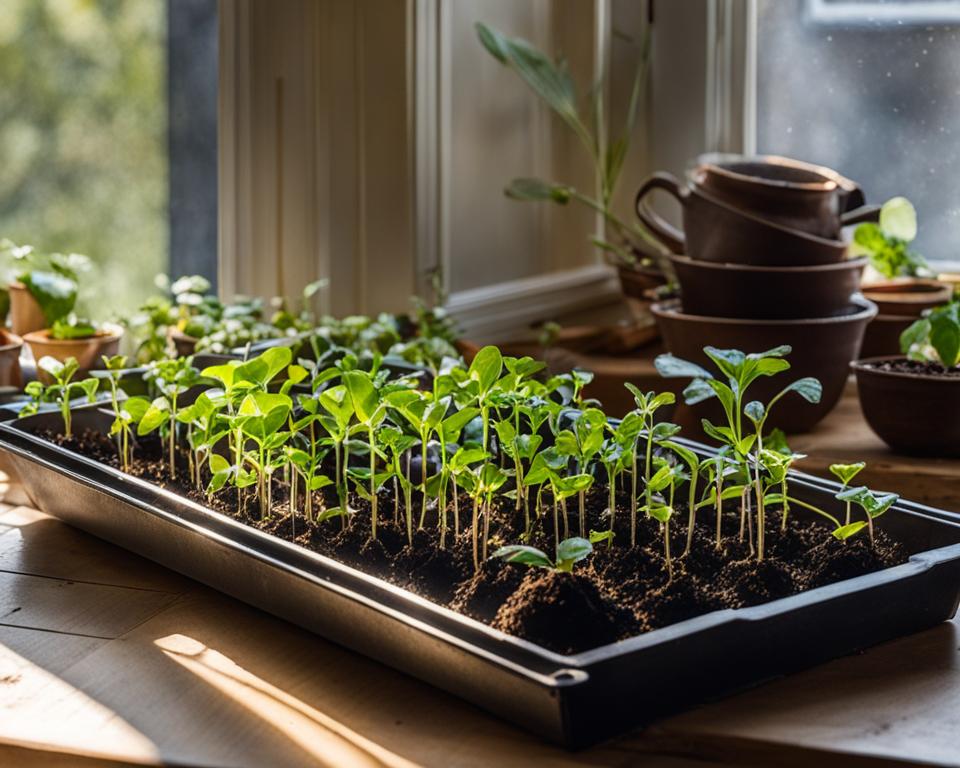
Pre-Growing Tips for Vertical Gardens:
- Consider starting plants indoors in pots or seed trays for optimal control over growing conditions.
- Gradually acclimate pre-grown plants to outdoor conditions by starting them in a temporary outdoor location.
- Monitor and adjust care for pre-grown plants to ensure strong root development and robust foliage.
- Experiment with different plant varieties and layouts during the pre-growing phase to optimize your vertical garden design.
Step-by-Step Guide to Building a DIY Vertical Garden
Creating your own vertical garden is a rewarding and fulfilling DIY project that allows you to maximize your gardening space and create a stunning display of plants. With a step-by-step approach, you can build a vertical garden that suits your space and meets your gardening needs. Follow this guide to get started on your own vertical garden:
1. Choose the Location and Design
The first step is to determine where you want to place your vertical garden and select a design that works best for your space. Consider factors such as sunlight availability, accessibility for watering and maintenance, and the overall aesthetic you want to achieve. Whether it’s against a wall, on a balcony, or freestanding, choose a location that provides the right conditions for your chosen plants.
2. Gather the Materials
Next, gather all the necessary materials for building your vertical garden. This may include wooden planks or pallets, PVC pipes, trellises, hanging planters, screws, nails, and a suitable potting mix. Make a list of everything you need and ensure you have all the materials on hand before starting the construction process.
3. Prepare the Structure and Fill with Soil
Once you have the materials, begin constructing the structure of your vertical garden. Follow the design you selected, ensuring that it is stable and secure. If using pallets, reinforce them and add a backing to hold the soil. Fill your vertical garden with a well-draining potting mix that is suitable for the types of plants you will be growing.
4. Select and Plant Your Desired Plants
Now comes the exciting part – selecting and planting your plants. Choose plants that are well-suited for vertical growth, such as climbing beans, cucumbers, or herbs like basil and mint. Consider the light and water requirements of each plant and ensure they are compatible with your chosen location. Plant them in the appropriate spots within your vertical garden, giving them enough space to grow and thrive.
With your DIY vertical garden complete, remember to provide ongoing care and maintenance. Regularly water your plants, keep an eye out for pests or diseases, and provide any necessary support or pruning as they grow. Enjoy the beauty and productivity of your vertical garden as it transforms your space into a green oasis.
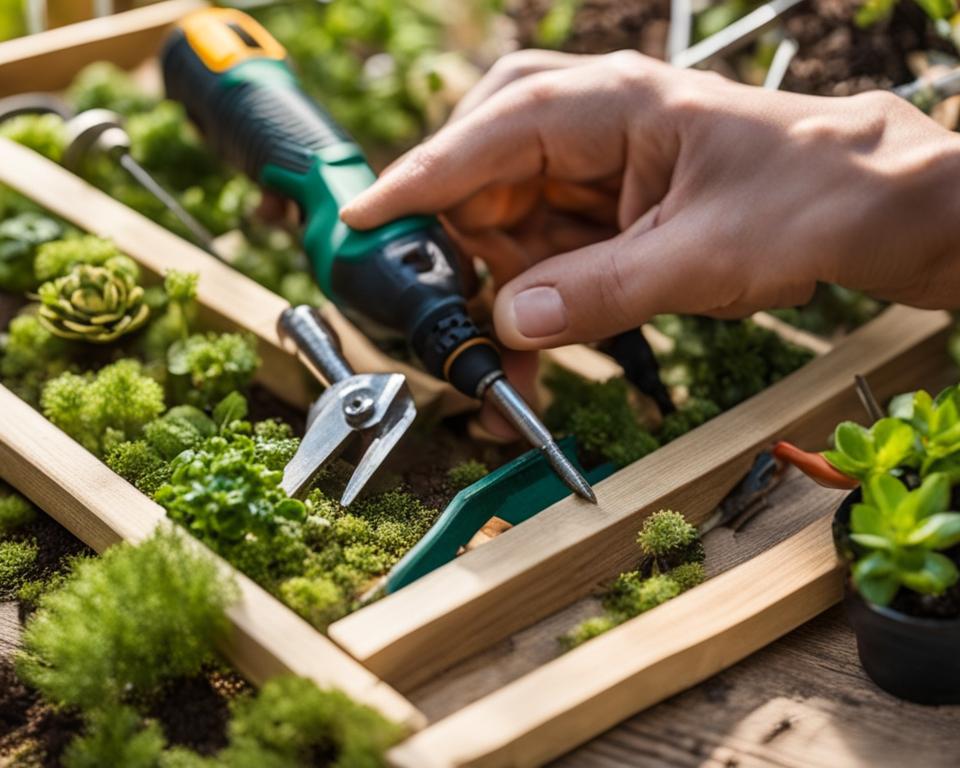
Create a table for the above text. It should have 4 columns and 2 rows. In the first row, the columns should be labeled “Step”, “Description” , “Tips” and “Image”. The second row should contain the corresponding information for each step. The image column should be empty since there is already an image in the section.
| Step | Description | Tips | Image |
|---|---|---|---|
| Choose the Location and Design | Determine the location and design of your vertical garden. | Consider sunlight, accessibility, and aesthetics. | |
| Gather the Materials | Collect all the necessary materials for building your vertical garden. | Create a list and ensure you have everything you need. | |
| Prepare the Structure and Fill with Soil | Construct the structure of your vertical garden and fill it with suitable soil. | Ensure stability and use a well-draining potting mix. | |
| Select and Plant Your Desired Plants | Choose plants suited for vertical growth and plant them in your vertical garden. | Consider light and water requirements for each plant. |
Conclusion
Vertical urban gardening has truly been a DIY success for me. The benefits of maximizing limited space, easier harvesting, and improved plant health have made it a sustainable and beautiful solution for my urban garden. By implementing DIY ideas and following best practices, I’ve transformed my city space into a lush, green oasis.
With the help of affordable materials and resourceful thinking, I’ve created functional and aesthetically pleasing vertical garden structures. Whether it’s using welded wire, recycled fencing, or repurposed pallets, there are endless possibilities for creating your own vertical garden on a budget.
Growing plants vertically has allowed me to expand my gardening space and increase my plant variety. I’ve experimented with climbing beans, cucumbers, and herbs like basil and thyme, which have thrived in my vertical garden. Starting plants indoors and pre-growing them has also ensured their health and resilience.
So, if you’re looking to embark on a rewarding DIY urban gardening journey, I encourage you to give vertical gardening a try. With the right location, design, materials, and care, you too can experience the joys of growing your own green oasis in the heart of the city. Start your own DIY vertical garden today and reap the benefits of a successful urban gardening project!
FAQ
What are the benefits of vertical gardening?
Vertical gardening maximizes limited space, improves harvesting, protects plants from disease, and adds beauty to your garden design.
How can I create an affordable vertical garden?
Instead of purchasing expensive trellises, consider using affordable alternatives such as welded wire, T-posts, cattle panels, chicken wire, or recycled fencing.
What plants are suitable for vertical gardening?
Plants like climbing beans or peas, cucumbers, melons, squashes, tomatoes, and herbs like basil, thyme, and mint are great choices for vertical gardens.
What DIY options are available for creating a vertical garden?
You can use a trellis or lattice against an existing fence or wall, an upcycled pallet transformed into a vertical planter, a hanging garden for small spaces, or a tower garden for a variety of herbs and vegetables.
What factors should I consider for successful vertical gardening?
Factors to consider include soil choice, water requirements, sunlight and temperature needs of plants, and proper spacing and watering.
How can I pre-grow plants for my vertical garden?
You can start plants indoors in pots or seed trays and gradually acclimate them to outdoor conditions, or start plants in a temporary outdoor location to adjust to natural conditions.
How do I build a DIY vertical garden?
Choose a location and design, gather materials, prepare the structure, fill it with suitable soil, select plants, plant them, and provide ongoing care and maintenance. Follow step-by-step instructions for a successful vertical garden.

